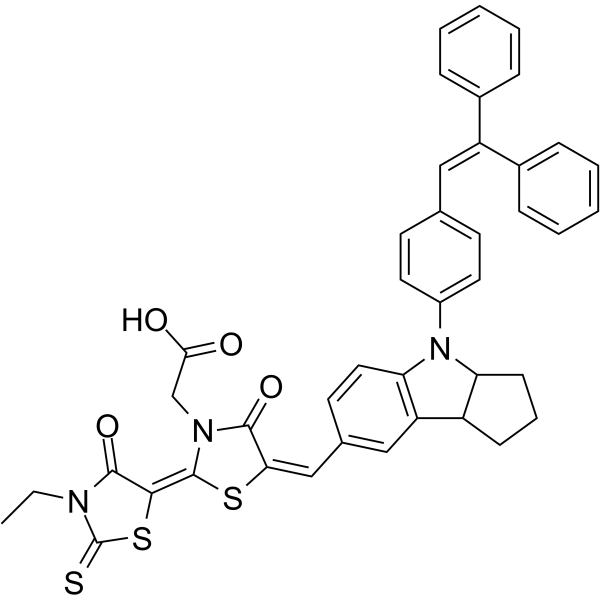D149 Dye;(Synonyms: D149; Indoline dye D149) 纯度: ge;95.0%
D149 Dye 是一种二氢吲哚类染料,是一种具有高消光系数的非金属有机敏化剂。

D149 Dye Chemical Structure
CAS No. : 786643-20-7
| 规格 | 价格 | 是否有货 | 数量 |
|---|---|---|---|
| 50 mg | ¥1800 | In-stock | |
| 100 mg | ¥2930 | In-stock | |
| 500 mg | ¥5800 | In-stock | |
| 1 g | ; | 询价 | ; |
| 5 g | ; | 询价 | ; |
* Please select Quantity before adding items.
D149 Dye 相关产品
bull;相关化合物库:
- Bioactive Compound Library Plus
| 生物活性 |
D149 Dye is an indoline-based dye, which is a high-extinction-coefficient metal-free organic sensitizer. |
||||||||||||||||
|---|---|---|---|---|---|---|---|---|---|---|---|---|---|---|---|---|---|
| 体外研究 (In Vitro) |
D149 is a metal-free organic dye, which is promising all-organic alternatives. D149 displays power conversion efficiency of up to 9%. Furthermore, D149 has a peak extinction co-efficient of 68700 M-1 cm-1 at 540 nm, significantly higher than 13900 M-1cm-1 at 535 nm for N719[1]. D149, a metal-free indoline dye, is one of the most promising sensitizers for dye-sensitized solar cells (DSSCs) and has shown very high solar energy conversion efficiencies of 9%. D149 shows a large number of unresolved aromatic and olefinic signals between 7 and 7.5 ppm[2] MCE has not independently confirmed the accuracy of these methods. They are for reference only. |
||||||||||||||||
| 分子量 |
741.94 |
||||||||||||||||
| Formula |
C42H35N3O4S3 |
||||||||||||||||
| CAS 号 |
786643-20-7 |
||||||||||||||||
| 运输条件 |
Room temperature in continental US; may vary elsewhere. |
||||||||||||||||
| 储存方式 |
4deg;C, protect from light *In solvent : -80deg;C, 6 months; -20deg;C, 1 month (protect from light) |
||||||||||||||||
| 溶解性数据 |
In Vitro:;
DMSO : 1 mg/mL (1.35 mM; Need ultrasonic) H2O : < 0.1 mg/mL (insoluble) 配制储备液
*
请根据产品在不同溶剂中的溶解度选择合适的溶剂配制储备液;一旦配成溶液,请分装保存,避免反复冻融造成的产品失效。 |
||||||||||||||||
| 参考文献 |
|
| Cell Assay [1] |
The porous TiO2 films are immersed in a 0.5 mM D149 (1-material) dye solution in a 1:1 (v/v) mixture of acetonitrile (HPLC) and tert-butanol (LR) overnight once their temperature decreased to approximately 110°C. The samples are then taken out of the dye bath, washed with acetonitrile, and dried. The working electrode and Pt counter electrode [produced using a pre-drilled piece of 2.3 mm FTO glass, coated with one drop of 10 mM platinic acid solution [H2PtCl6] and heated to 400°C for 20 min] are assembled into a sandwich type cell and sealed with a spacer of 25 μm Surlyn. An I-1/I3-1 organic solvent based electrolyte solution [50 mM iodine, 0.6 M 1,2-dimethyl-3-propylimidazelium iodide, 0.1 M lithium iodide in methoxypropionitrile] is introduced via vacuum back-filling. The hole is sealed with a piece of aluminium foil-backed Surlyn[1]. MCE has not independently confirmed the accuracy of these methods. They are for reference only. |
|---|---|
| 参考文献 |
|
